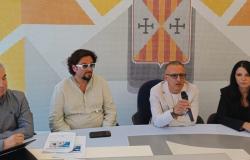
In via Giustiniano in Aprilia, an experiment on the streets that began in 2016 led to stunning resultswhich could significantly reduce costs for road maintenance and solve the pothole problem which now afflicts all cities. But no administration seems to notice.
Aprilia, via Giustiniano, famous for potholes
We are in Aprilia in a neighborhood built around the end of the 70s which has a large number of buildings of 8 or more floors. A neighborhood initially called “Zona Canebi” which already presents serious problems during the construction phase. There are failures that bring companies and individuals to court (some cases still continue today). But what interests us in this story are the streets.
The area, today called the Agroverde District, is crossed by numerous streets, many bearing the names of Roman emperors. This is the case for via Giustiniano, a road that joins via De Gasperis and via Aldo Moro, two major thoroughfares in the city center of Aprilia.
Over time, the road has become quite important given that today it is home to the ASL LT1 health clinic, the offices of the Municipality of Aprilia, and the barracks of the Carabinieri Company.


The peculiarity that this road, just over 700 meters long, has shown since the 1970s is that it is always filled with potholes. First the asphalt starts to show the classic cracks, called ‘cobweb’ or even ‘crocodile skin’. Then large stones of asphalt begin to detach and consequently the potholes appear.
Neither continuous patching nor resurfacing solves the problem for decades. All it takes is a little rain and even the freshly laid asphalt starts its destructive cycle again.
Probably due to the road surface not being well prepared or the geomorphological characteristics of the terrain, the road is always a continuous battlefield.
The ‘miraculous’ intervention
In the June 2016also documented by an article in Il Caffè (read the 2016 article “”Intelligent” asphalt arrives in Aprilia: experimentation in via Giustiniano”), the Municipality of Aprilia decides to experiment with an innovative solution in the stretch of via Giustiniano included between via dei Bersaglieri and via Tiberio, in practice between the ASL and the Carabinieri.

Before laying yet another strip of asphalt as usual, which would only last a few months intact, a special sheath is laid. In reality it is nothing surprising, given that this solution had already been successfully adopted for the GRA of Rome.
What was amazing at the time was that it should last at least 2 years without having to intervene with any maintenance.
With some skepticism we concluded our 2016 article with “We’ll see!”.
Well today we are in June 2024, 8 years after the experiment, and that stretch of via Giustiniano has never required any maintenance.
Anyone who travels along it today can see the signs of wear, such as some depressions or a hint of the famous “cobwebs” of the asphalt, but in the points where the sheath was laid a hole has never been created, not even having to intervene with a shovelful of asphalt.
The ‘intelligent’ asphalt. Why don’t they adopt it?
They call it, with a bit of irony, “intelligent asphalt“. Perhaps to indicate that the administrator who is persuaded to use it is a little more intelligent than the one who ignores it?
In the intervention on via Giustiniano in 2016 the costs were a little less than doublecompared to normal asphalting. Laying the normal asphalt cost 7 euros per square meter, adding the sheath another 6 euros per square meter.
But given this expense, the advantages that have emerged are truly enormous.
No more potholes the Municipality of Aprilia saved 8 years of maintenance interventions and continuous resurfacing which would certainly have happened. For all these years, citizens have been able to enjoy a road as smooth as billiards, safer and without those traps caused by potholes that appeared suddenly and continuously.
And probably in these 8 years technology has improved this solution even more, perhaps even lowering costs.
Ultimately, everyone benefits. But then, why doesn’t Aprilia apply this solution at least on the notoriously most problematic sections of road?
Why don’t all the other municipalities do it?
And I would add, provocatively: why are there no intelligent administrators?





